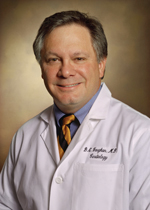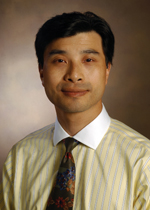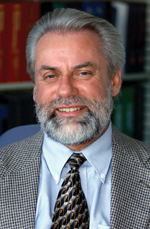
Douglas Vaughan, M.D.
Bone marrow stem cells studied to renew heart muscle

David Zhao, M.D.

Friedrich Schuening, M.D.
Vanderbilt University Medical Center will be the first center in the state and one of three sites in the country to begin Phase 1 clinical trials using bone marrow stem cells to regenerate the heart muscle following a heart attack.
The clinical trial, which began this week, is expected to enroll at least 20 patients. A total of 50 patients will participate in the randomized, multi-center study that includes Emory University in Atlanta and Texas Heart Institute in Houston.
The study is being funded by New Jersey-based Amorcyte, a privately funded cell-therapy company that develops projects to treat cardiovascular disease.
“This is an exciting opportunity to get into the field of regenerative medicine of the heart,” said Douglas Vaughan, M.D., chief of the Division of Cardiovascular Medicine. “We don't have all the answers about cardiac cell-therapy, but we do know that we have to start doing these trials to start finding the answers to the questions.”
One of the major obstacles in treating patients after a heart attack is the inability to repair the damaged muscle. In about 20 percent of heart attack patients, the muscle loss is permanent, which leads to worsening of the heart function and, ultimately, heart failure.
Heart disease is the leading cause of death in the United States — 5 million people suffer from heart failure while nearly half of them die each year. Vanderbilt cardiologists are hoping that this novel, cell-based therapy will serve as one tool they can use in the fight against heart disease.
This is how the treatment works:
Adult patients presenting in the Emergency Department with chest pains will be evaluated using an EKG to determine if the patient is having an acute heart attack. If an angiogram shows any blockage in the artery, doctors will repair the blocked artery using a stent or balloon angioplasty to open it up. If tests show a decrease in heart function or impaired ventricular function, the patients will qualify for enrollment into the trial.
Half the patients successfully admitted into the study will receive an infusion of their own bone marrow cells while the other patients will receive the standard treatment.
Patients randomized to the stem cell arm of the study will have their marrow collected by the stem cell transplant team at Vanderbilt. The cells will be shipped to Amorcyte, who will process the sample and enrich the CD34+ cells, which contain marrow stem cells. The mechanism for how marrow cells help healing attacked hearts is still unclear. It is the source of ongoing research.
Within 24 hours the sample will be shipped back to the hospital and injected into the patient via a catheter directly into the coronary artery where the cells will diffuse into the heart muscle.
David Zhao, M.D., expects to see improvement in the heart function within three to six months after the infusion.
“Right now we can treat a lot of diseases affecting the heart,” said Zhao, director of the Cardiac Cath Lab. “We have not made significant strides in the fact that we can do nothing more than treat symptoms in patients with a dying heart. What we hope is to one day be able to treat the entire heart without surgery and use the bone marrow cells to repair the heart.
“This will be revolutionary from the treatment standpoint.”
Europe has been the site for much of the heart-related cell-based therapies. Now a few centers in the United States are exploring the treatment option.
Patients entering the trial will be followed for up to one year at three-month intervals. Assessment tools, aside from a clinical visit, will include echocardiograms and a cardiac MRI, which will be able to show doctors in detail the ventricular structure and function of the heart. This will allow them to examine the wall of the heart for thickness and ability to contract — both used as measuring tools for success.
“If this technology is successful then we can use it for patients with heart failure and cardiomyopathy so that the application is broadened,” said Zhao. “That would take between three and five years to expand. But regardless of the reason for the heart attack, to be able to replace the dying heart muscle and take a dying heart, a diseased heart, into a functioning healthy heart will be an enormous success.”
Vaughan said steps have already been taken to educate Vanderbilt physicians as well as referring clinicians about the new therapeutic approach and the new direction it can potentially offer in cardiovascular disease treatments.
For Friedrich Schuening, M.D., chief, Section of Hematology and Stem Cell Transplant, the collaboration between the two divisions has been exciting.
For several years Schuening has known about the merits of stem cell therapies in Europe, but had to be patient for the approval for such research in the U.S. Now that Vanderbilt is among the institutions forging ahead in this arena, he is encouraged.
“This shows that cell-therapy in general will become an important treatment modality in the future,” said Schuening. “The main application for cell therapy has been bone marrow transplantation. Another area for this kind of therapy is used in the treatment of genetic diseases like hemophilia and other blood disorders.”
The multi-disciplinary collaboration for the use of stem cells in cardiovascular regeneration has opened up other activities including a grant proposal submitted to become a National Institutes for Health (NIH)-approved clinical trial site as well as a grant application to study how the stem cells work in cardiovascular disease to repair the heart muscle.













